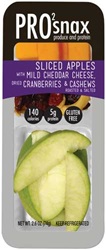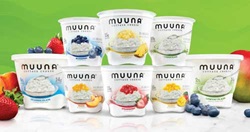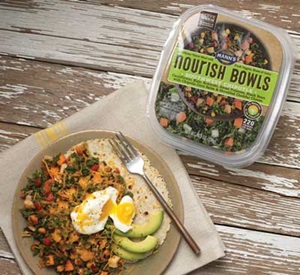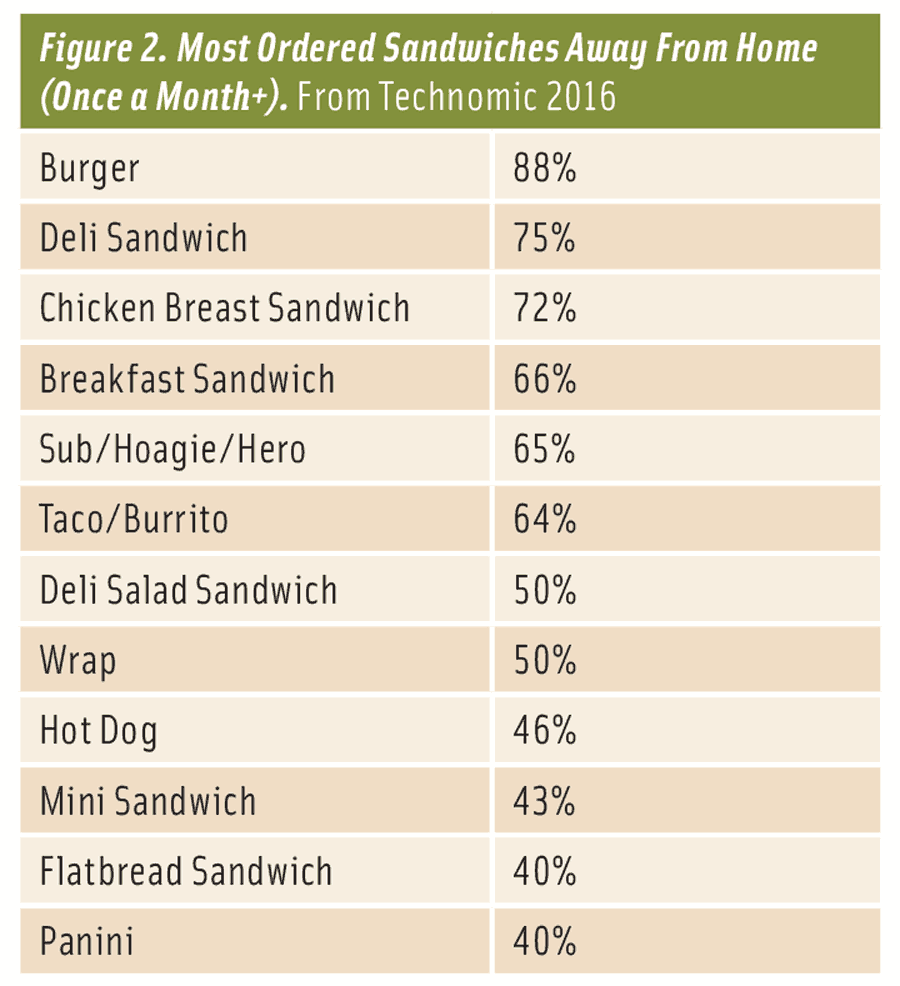
Shoppers Shift to Fresh
Single-serve packaging, fresh snacks, health claims, and gourmet ingredients are driving explosive growth in the $149 billion fresh food marketplace.
Article Content
Better alignment with today’s food lifestyle needs is fast accelerating food shoppers’ shift to fresh. From 2011 to 2015, annual growth in fresh perimeter departments of the supermarket—meat, produce, deli, bakery, seafood, and dairy—grew 5.1% versus the center store at 2.2% growth (Nielsen 2016a).
Fresh-format retailers (grocers with more than 50% of their sales from fresh) saw total store sales grow 9.8% in 2015. Retailers with 30% or less of sales from fresh reported a sales decline of 6.1%. Fresh-format store sales are projected to grow 8.6% annually through 2020, second only to grocery e-commerce at 26% annual growth (IDDBA 2017).
One-third (35%) of consumers now regularly buy fresh foods at convenience stores; 52% bought a preprepared or made-to-order meal at a c-store in the past month (Acosta 2016). C-store foodservice sales are projected to reach $30 billion by 2020, up from $22.6 billion in 2015 (Mintel 2016a).
The percentage of all in-home eating occasions that include fresh foods is almost back to levels seen 30 years ago (NPD 2015). Just over half (53%) of all meals prepared at home now use some semiprepared fresh items such as precut vegetables, precooked meat, or heat-and-eat mashed potatoes; 35% are mostly cooked from scratch; and 13% rely on semiprepared and fully prepared items that simply require reheating (FMI 2016a).
The number of occasions at which consumers eat alone has increased from 35% in 2012 to 46% in 2016, which is significant because when consumers eat alone they are more likely to choose fresh foods (Hartman 2016).
Fifty-one percent of eating occasions are snacks, and 17% of foods are now consumed within one hour of purchase, up from 15% in 2013 (Hartman 2016). Not surprisingly, sales of snack-size vegetables grew at twice the rate of their larger counterparts; fresh-cut single-serve fruit sales climbed by 9.9% in 2015. Sales of individual bakery desserts jumped 18% (IRI 2016a).
In grocery stores including Walmart, Target, and Sam’s Club, deli prepared foods posted the strongest growth among perishable department categories for the year ended (Y/E) March 27, 2016, per Nielsen, with dollar sales up 9.3% to $11.0 billion. Other segments with strong growth stories include seafood, +6% to $4.7 billion; in-store delis, +4.9% to $24.6 billion; produce, +4.8% to $62 billion; in-store bakeries, +4.2% to $11.4 billion; and meat, +2.6% to $49 billion. In dairy, yogurt sales grew 2.4% to $7.6 billion, natural cheese sales flattened (+0.8%) at $13.1 billion, and milk sales declined by 8.1% to $14.6 billion (Gallagher 2016).
In 2015, refrigerated foods were the fifth-best-performing consumer product category overall after beverages, health-care products, liquor, and tobacco. Refrigerated lunches were the fastest-growing food/beverage category, with sales up 14.2% over 2014, followed by refrigerated tea and coffee. Natural cheese and fresh bread/rolls held their ground among the top 10 largest food/beverage categories (IRI 2016b).
The top 10 fastest-growing fresh product categories in terms of 2015 dollar sales growth include ground meat other than beef, +38.6% versus 2014; seafood side items, +21.2%; deli beverages, +18%; brownies/dessert bars, +17.4%; deli prepared breakfast foods, +15.7%; deli prepared soup, +15%; deli prepared sushi, +14.9%; avocados, +14.1%; produce beverages, +13.8%; and ornamental produce, +12.4% (Nielsen 2015).
Produce and milk remain the top trip-driving categories (purchased on 44% of all household grocery trips), followed by meat and eggs. One in three trips includes a visit to the deli; 28% of trips include a bakery visit; 27%, a meat department visit; and 5%, a seafood counter stop (IDDBA 2017). Deli foods and nuts/dried fruit are among the top perimeter impulse categories (Nielsen 2016b).
Although those living alone now account for 28% of U.S. households, they’re the least likely to shop in fresh departments and represent a huge untapped opportunity for single-portioned items (IDDBA 2017). Flowers Foods has introduced a “right-sized” package of its Cobblestone Bread.
Likewise, with one-third of households with children regularly shopping the fresh perimeter, especially the bakery, the current limited availability of kid-specific fresh items is a serious barrier to growth (IDDBA 2017).
Two-thirds (63%) of Millennial parents are trying to avoid processed foods versus 56% of Millennials overall. For Baby Boomers, the figure is 52%, and for Gen Xers, it is 48% (Mintel 2016b). The impact of clean label, all-natural, free from, and nutrition is highest for fresh prepared meals, where it influences 66% of purchase decisions; for both meat/poultry/fish and the deli, it influences 49%; for fresh bread/bakery and fruits/vegetables, 44%; and for refrigerated dairy, 42% (Deloitte 2015).
Lastly, 48% of Americans define themselves as foodies, but many younger adults have limited cooking skills, so the demand for skilled in-store culinary professionals is unprecedented (Packaged Facts 2015a). Eight in 10 grocery retailers have a butcher on staff; 51%, a seafood expert/fishmonger; 46%, a scratch baker; 28%, a trained chef; and 25%, a cheesemonger (Webber 2016).
Deli Dining Dynamics
Prepared foods dominate deli sales, contributing 57.2% of deli dollars for the Y/E April 2, 2016, followed by deli meat, 20.7%; deli cheese, 17.8%; deli beverages, 4%; and other deli items, 0.3% (IDDBA 2017). Just over half (52%) of adults use deli prepared foods; singles, households with young children, and Millennials are most likely to do so (FMI 2016a).
Sushi and soup led sales growth among deli prepared foods for the Y/E April 2, 2016, with sales up 14% and 12.4%, respectively, followed by salads, +8.1%; snacks, +7.9%; sides, +7.8%; sandwiches, +7.6%; pizza, +7.2%; and entrées, +7.1%, per Nielsen (IDDBA 2017).
In the fresh-prepared category, top performers include meatloaf, with sales up 66% in 2015; guacamole, +51%; barbecue chicken, +37%; pulled pork, +32%; pasta entrées, +24%; breakfast entrées, +14%; Mexican entrées, +10%; and appetizers, +9% (IRI 2016c).
Tukey, ham, beef, chicken, and salami remain the top bulk deli meats; all-natural chicken sales jumped 14.4% for the Y/E April 2, 2016. Salami and Italian specialty meats posted the largest gains in presliced deli meats, per Nielsen (IDDBA 2017).
Specialty cheeses (which account for two-thirds of deli cheese sales) and presliced cheeses, each posted gains of 4.5% in dollar sales, per Nielsen. American, Swiss, cheddar, provolone, parmesan, Muenster, Gouda, and Colby Jack are the top-selling deli cheeses by volume (IDDBA 2017).
 Beyond the deli, ingredient, sandwich, and chunk cheeses account for nearly two-thirds of cheese product sales. Sales growth leaders include snacking cheese, +6.7%; cottage cheese, +6.4%; imported cheese, +5.4%; and ricotta, +3.7% (IDDBA 2017). PRO2snax produce and protein snacks in apple, cheddar, and nut varieties from Reichel Foods are right on target.
Beyond the deli, ingredient, sandwich, and chunk cheeses account for nearly two-thirds of cheese product sales. Sales growth leaders include snacking cheese, +6.7%; cottage cheese, +6.4%; imported cheese, +5.4%; and ricotta, +3.7% (IDDBA 2017). PRO2snax produce and protein snacks in apple, cheddar, and nut varieties from Reichel Foods are right on target.
Whole-fat cheese accounts for 91% of cheese sales volume and continues to grow, with sales up 3.6%; low-fat fell 1.2%, reduced-fat cheese sales declined by 4.2%, and sales of fat-free cheese plummeted—down 12.4% (IDDBA 2017).
Six in 10 deli operators plan to enhance their sandwich programs; half anticipate enhancing their lunch offerings (Horovitz 2016a). In 2015, 16% of adults bought a sandwich from the supermarket deli or c-store weekly; those aged 25–44 were most likely to do so. Younger adults aged 18–24 were 30% more likely to visit a sandwich shop; 31% had visited a Subway shop in the past 30 days—clearly a lost deli opportunity (Packaged Facts 2015b).
Peanut butter and jelly, grilled cheese, and sandwiches made with deli salads were the most popular sandwiches eaten at home (Datassential 2014). While burgers and deli sandwiches remain the most popular away from home, chicken breast and breakfast sandwiches are closing the gap. Four in 10 consumers order mini, flatbread, or panini sandwiches (Technomic 2016, Figure 2).
Over the past two years, bread has inched out protein as the most important part of the sandwich (Datassential 2014). Consumers are more likely to experiment with bread than any other sandwich ingredient. Pretzel, brioche, artisan, and ciabatta breads posted the largest gains on restaurant menus over the past four years. Ethnic sandwiches and their traditional carriers (e.g., naan bread) remain fast-emerging sandwich trends (Packaged Facts 2015b).
All-natural, local, and whole grain are the claims most likely to favorably influence shoppers to buy a deli item. Claims such as hormone-free, grass-fed/pasture-raised, sustainably caught or raised, free-range, antibiotic-free, organic, heirloom, cage-free, and non-genetically modified (GM) influence nearly two-thirds of deli shoppers (Culinary Visions 2015).
Sales of deli meats that boast a “no antibiotics ever” claim jumped 29% in 2015; sales of deli organic cheese were up 66%. No antibiotics ever and organic deli meat contributed 8% to total deli sales growth in 2015 (IRI 2016d).
Lastly, if sales continue at their present pace, fresh food kits will likely be another boon for the deli. Packaged Facts (2016) estimates the food kits business at $1.5 billion in 2016. Six in 10 adults ordered food for takeout in the past six months, 44% for home delivery (Morgan Stanley 2016).
On the Center of the Plate
With the U.S. Dept. of Agriculture (USDA) predicting deflation of meat/poultry prices, sales of value-added meats outpacing the category overall, health claims driving double-digit growth, and culinary curiosity about new cuts/alternative proteins at an all-time high, the meat department’s future looks very good indeed.
On average, home-cooked dinners that include meat/poultry are served 3.7 nights per week, the same as last year, but down from an eight-year average of 4.1 nights weekly (FMI 2016b). Nearly six out of 10 U.S. households (58%) serve chicken two to three times per week. Beef is served that often by 47% of households; pork by 26%; and fish/seafood by 25% (FMI 2016b).
Smaller portions and package sizes—especially single- or two-person servings—top the list of the fastest-growing customer demands in the meat department, followed by more value-priced items (Horovitz 2016b). Forty-three percent of operators report increased interest in value-added products, including premarinated offerings, kebabs, gourmet burger mixes, loaves, and meatballs (Horovitz 2016b). More than half of shoppers now serve ready-to-eat and heat-and-eat meats at least once a week (FMI 2016b).
Half of shoppers say they’re regularly buying leaner cuts of meat; nearly a third (31%) are cutting down on meat portion size (FMI 2016b). Seventy percent of adults associate meat with protein, iron, and other nutrients. Six in 10 Millennials believe meat provides energy, and 53% say that meat builds physical strength (FMI 2015).
Fifty-eight percent of meat department operators reported increased demand for free-from products (e.g., free from antibiotics, hormones, MSG, and additives). There is also significant increased demand for grass-fed beef, organic meats, and locally raised meats (Horovitz 2016b).
“Made/raised in the USA” is the meat claim that is most important to consumers. Not surprisingly, state-branded meats are grabbing consumers’ attention (e.g., Harris Ranch’s Premium Grass Fed Beef is “California grown, fed, and processed”). The company’s finished beef is tested for pesticide and antibiotic residues, per USDA standards (FMI 2016b).
From 2011 to 2015, dollar sales of organic meats grew 30% per year, according to Nielsen; sales of hormone-free and natural grew almost as strongly, and antibiotic-free and preservative-free meats were also strong performers (Mandzy 2016).
Sales of “no antibiotics ever” meat reached $2.9 billion in sales, up 23% in 2015. Organic meat sales topped $582 million, up 32% (IRI 2016e). More than half of U.S. adults say that the humane treatment of food animals is very important to them (Hartman 2015).
Half of meat department operators report that customers want more premium beef, more new cuts of meat, and more alternative proteins (Horovitz 2016b). Not surprisingly, similar customer demands are surfacing in the fish/seafood department. Operators report two-thirds want smaller package sizes, more value-priced offerings, and more free-from items; 43% of consumers say they want more value-added, precooked, and preprepared items (Horovitz 2016c).
 Fresh Successes in Bakery
Fresh Successes in Bakery
Fresh bakery has had the best performance in years and is becoming increasingly important to retail success. Fresh in-store bakery sales rose 34.2% to $11.4 billion for the Y/E March 27, 2016. Seven in 10 bakery operators, up from 50% last year, report that their department is now included in “one-stop-shopping trips” (Horovitz 2016d).
Bread remains the best-selling bakery item, followed by cakes, doughnuts, cookies, rolls, pies, bagels, and sweet rolls (Horovitz 2016d). Nielsen reports that for the Y/E Feb. 27, 2016, pies posted the biggest bakery gains, +24.2% in sales volume, followed by brownies/dessert bars, +8.9%; cookies, +6.4%; muffins, +4.5%; cakes, +3.2%; and bagels, +2.7% (Nielsen 2016a).
In descending order, bakery operators ranked celebration cakes, seasonal specialties, signature/specialty items, gluten-free, and single-serving/smaller portion sizes as the hottest growth areas for in-store bakery products (Horovitz 2016d).
For decorated cakes and cupcakes, the trendy cake colors include electric blue, tangerine, turquoise, eggplant, stone gray, and lime green, per DecoPac. Black wedding cakes, metallic cakes, geode cakes made with rock candy, and hand-painted cakes are other hot trends (IDDBA 2017).
For the Y/E May 28, 2016, sales of mini pies jumped 21%, sales of mini muffins/cookies were up 11%, and sales of individual dessert cakes and bars each were up by more than 10% (Nielsen 2016c). Nearly 60% of individual item purchasers were singles living alone and married couples without kids, those currently the least likely to shop in the in-store bakery (IRI 2016a).
With a new early morning snacking occasion, breakfast pastries have an enormous opportunity to reinvent themselves: 40% of all consumers eat breakfast pastries, and 30% have bakery muffins to start their day (IRI 2016e).
Ethnic and herbal breads as well as unique sandwich carriers are in high demand. George Weston Bakeries’ Wonder+ square bagels bring a new shape to the bagel category. Better4U Foods offers edible bread bowls.
One-third of consumers turned to healthier breads in 2015 (FMI 2016c). With 95% of all items sold in the in-store bakery having no declared health benefit—and whole grains, dietary fiber, and protein still the most sought after nutrition claims—touting nutrition content descriptors on fresh bakery products at point-of-sale is a very big idea (IDDBA 2016).
Among the 5% of in-store-bakery fresh products that do carry health claims, “no trans fat,” “gluten-free,” “no sugar added,” and “whole grain” are the most popular, according to Nielsen (IDDBA 2017). Growth in gluten-free in the bakery has begun to level out (Hale 2016).
In-store fresh organic bakery sales totaled $283 million, up 9.7% in 2015 (OTA 2016). Consumers say ingredients are the most important component in making a truly great cake (Datassential 2015).
Grocery products containing ancient and sprouted grains were purchased by 16% and 15% of consumers, respectively, in 2015 (Packaged Facts 2015c). Nonwheat and ethnic flours maintain their appeal. Low-or no-sugar cakes/pies are of interest to 25% of consumers (IDDBA 2017).
Texture (e.g., crispy, crunchy, thin) is another new bakery item differentiator. Take-and-bake cakes, bread, and pizza; dessert “bars”; and smaller packages for smaller households are in demand in bakeries. With consumers most often defining fresh in convenience stores as “freshly baked,” it’s not surprising that well-informed operators are adding in-store fresh bakeries (Mintel 2016a).
Hot Spots in Dairy
The dairy sector is alive with innovation, and despite sluggish sales, it’s likely the category won’t be struggling for long. The addition of new flavors/forms, a return to indulgence/full fat, convenient packaging, and options that are organic, high in protein and calcium, or lactose-free are giving stagnant dairy categories a new lease on life.
 Fairlife milk—whose filtration process concentrates some of milk’s natural nutrients, making it 50% higher in protein, 30% higher in calcium, lactose-free, and 50% lower in sugar than regular milk—was among the best-selling new U.S. foods/beverages in 2015, with year one sales of $87 million (IRI 2016f).
Fairlife milk—whose filtration process concentrates some of milk’s natural nutrients, making it 50% higher in protein, 30% higher in calcium, lactose-free, and 50% lower in sugar than regular milk—was among the best-selling new U.S. foods/beverages in 2015, with year one sales of $87 million (IRI 2016f).
HP Hood’s whole milk Lactaid jumped 17% in dollar sales for Y/E Sept. 4, 2016, and Horizon Organic’s and Organic Valley’s whole milk sales also shot up (Carper 2016).
Although reduced-fat milk still outsells whole milk, full-fat milk volume grew 4.9% from Jan. 1, 2016, to July 10, 2016, per IRI. Similarly, while low-fat yogurt is still the most popular, sales of whole-fat yogurt grew 16.3%, while sales of low-fat, reduced-fat, and fat-free yogurt are all flat or declining (IDDBA 2017).
Flavored milks remain a bright spot in the dairy case, with sales topping $1.5 billion, up 3.7%, per IRI (Carper 2016). Limited-time and seasonally flavored offerings like Limited Batch Pumpkin Pie Spice Butter Spread from Land O’Lakes are helping to drive growth.
Flavored, seasonal, culinary, and clarified butters are helping to drive butter sales over the $2 billion mark, up 65% from 2000 and up 3.6% for the Y/E May 8, 2016—a 40-year high, while margarine and spread sales fell 8.1% (Keller and Henry 2016). Minerva Dairy offers a new Amish Roll Butter, Grassland Dairy is introducing unsalted clarified butter in tubs, and Epicurean Butter has a line of chef-inspired finishing butters.
 Whipped topping, cream/creamer, and sour cream sales, including flavored varieties, grew 7.6%, 5.1%, and 2.4%, respectively. Free of artificial sweeteners and flavors, Muuna cottage cheeses are packed in individual cups with fruit on the bottom in varieties like mango, blueberry, and pineapple, among others. With cream cheese and refrigerated dairy dip sales flat, it’s clearly time to pursue some innovative new flavor enhancements in the category.
Whipped topping, cream/creamer, and sour cream sales, including flavored varieties, grew 7.6%, 5.1%, and 2.4%, respectively. Free of artificial sweeteners and flavors, Muuna cottage cheeses are packed in individual cups with fruit on the bottom in varieties like mango, blueberry, and pineapple, among others. With cream cheese and refrigerated dairy dip sales flat, it’s clearly time to pursue some innovative new flavor enhancements in the category.
Although growth in the massive $7.5 million yogurt category has slowed, drinkable yogurt and yogurt-based smoothies are projected to enjoy significant growth, along with kefir, although the latter is a much smaller category (Carper 2016). For the Y/E June 12, 2016, sales of kefir topped $110.9 million, up 16.8% (IDDBA 2017).
Despite a wide range of global/ethnic yogurts being introduced, extremely low awareness of their attributes will likely hamper sales. According to recent research, only 3% of consumers were aware of Icelandic-style yogurt in 2015 and only 5% were aware of kefir (Packaged Facts 2015d). Trimona Foods offers organic Bulgarian yogurt made with milk from grass-fed cows in varieties like Honey Ginger Cinnamon and Blueberry Lavender.
While a few flavors dominate (strawberry accounts for about 25% of yogurt sales), there is still plenty of room for flavor innovation and category sales growth. Noosa yogurt comes in a Mexican Chocolate flavor, for example, and noosa yogurt dips are available in Raspberry Habanero and Mango Sweet Chili flavors.
New product forms that improve ease of use are also grabbing customers’ attention. Litehouse Foods introduced Simple Seasons finely crumbled soft cheese in a convenient glass shaker container. Daisy sour cream comes in a squeezable package. Arla cream cheese is available in an easy-to-scoop tub.
Almond milk continues to dominate the alternative dairy beverage category, with sales up 2.7% to $908.9 million; coconut milk posted the largest gains, up 8.6% to $64.1 million, per IRI. Refrigerated soy milk sales fell 9.4% to $272.1 million for the Y/E Sept. 4, 2016 (Carper 2016).
Lastly, beyond dairy products, eggs were the best-selling item in the dairy case, with sales up 20% for the Y/E May 24, 2016. Egg substitute sales fell 5.7%, and refrigerated baked goods were down 1.7%. Sales of refrigerated flatbread and refrigerated juice drinks both were flat (IDDBA 2017).
Producing Fresh Sales
Chipotle Red Potato Lettuce Cups from Black Gold Farms, RPE Produce’s Take & Shake single-serve microwavable cups of bite-sized baked potatoes, and Mann Packing Co.’s Culinary Cuts Sweet Potato Ribbons and Butternut Squash Zig Zags fresh vegetable pasta alternatives are among the on-trend products driving produce sales to an estimated all-time high of $60.5 billion in 2016 (Strailey 2016).
Convenient forms account for 39% of all sales in the fresh produce department (Strailey 2016). Half of all new produce items introduced in the past year carried a convenience claim (Mintel 2016c). Vegetables account for nearly half (48%) of sales in the produce department; fruit for 41%; nuts, 2.2%; refrigerated salad dressing/dips, 2.1%; and premium juices, 1.7% (Strailey 2016).
Within the packaged salad category, complete salads/kits grew the fastest, up 31%, followed by organic salads, up 12% for the Y/E July 2, 2016 (Nielsen 2016a). Apio’s chef-inspired Eat Smart Strawberry Harvest Vegetable Salad Kits contain seven superfoods and a strawberry vinaigrette dressing. Walmart has introduced the Signature SideKicks fresh-cut vegetable mixes and culinary sauces from Robert Irvine Foods.
Avocados topped dollar sales volume gains in the fruit sector, up 12.4% for the Y/E July 2, 2016, followed by specialty fruits, melons, value-added fruit and grapes, and citrus (Strailey 2016).
Refrigerated produce dip sales shot up 12% along with refrigerated beverages sold in the produce department, +11.1% for the Y/E July 2, 2016 (Strailey 2016). Sales of fresh-squeezed juice, infused water, and produce smoothies grew 22% in 2015 and a whopping 105% over three years (IRI 2016a).
Mucci Farms’ naked leaf living herbs are greenhouse grown and offer longer-lasting freshness with their roots intact. Purple sweet potatoes, jackfruit, baby colored carrots, pink lemons, fresh lychee, and celery root and cauliflower puree are among the new offerings from specialty produce purveyor Frieda’s.
New produce forms that substitute for traditional sides (e.g., pasta, rice, or potatoes) or main meals (e.g, risotto) represent an exciting new product direction. New cauliflower pearls from Taylor Farms can be used as a replacement for rice, mashed potatoes, or pizza crust.
With sales of just over $13 billion in 2015, organic fruits/vegetables represent 12% of all fruit and vegetable sales (OTA 2016). One-third of produce department operators report that their sales of organic produce have increased over 2015 (Strailey 2016).
Sales of fresh fruit/vegetable snack packs continue to soar. Snacking tomatoes posted the largest dollar sales gains in the tomato category (Nielsen 2016a). Kraft Anytime! Anywhere! two-serving salad dressing pouches introduced last year are right on target as on-the-go dips. Compact CuteCucumbers from Mucci Farms and Adorable Kumquats from Frieda’s are among the new miniature fruits/vegetables packaged as on-the-go snacks.
 Produce-based meals, bowls, and kits are moving center stage. Mann Packing’s new vegetable-based Nourish Bowls come in varieties like Cauli-Rice Curry and Monterey Risotto. Seneca Foods Corp.’s 4-ounce microwavable Organic Vegetable Cups are among the first single-serve fresh side dish options.
Produce-based meals, bowls, and kits are moving center stage. Mann Packing’s new vegetable-based Nourish Bowls come in varieties like Cauli-Rice Curry and Monterey Risotto. Seneca Foods Corp.’s 4-ounce microwavable Organic Vegetable Cups are among the first single-serve fresh side dish options.
Litehouse Foods’ new fresh Guacamole Herb & Spice Blend packaged in a jar ensures a perfect dip every time. The consumer simply adds avocado and lime to the herb and spice blend; minimal chopping is required.
Earthbound Farm’s PowerMeal Bowls feature nutrition information callouts on the front of the package; Bard Valley Natural Delights dates use their packaging to tout the fact that they offer “50% more potassium than bananas.”
A. Elizabeth Sloan, PhD, a professional member of IFT and contributing editor of Food Technology, is president, Sloan Trends Inc., Escondido, Calif.
([email protected]).
References
Acosta. 2016. The Why Behind the Dine. Acosta Marketing, San Diego, Calif. acosta.com.
Carper, J. 2016. “State of the Industry.” Dairy Foods 117(11): 26–64.
Culinary Visions. 2015. Panel: Deli Shoppers. Culinary Visions Panel, Chicago, Nov.
Datassential. 2014. The Keynote Report: Sandwiches. Sept. Datassential, Los Angles. datassential.com.
Datassential. 2015. The Keynote Report: Desserts. Jan.
Deloitte. 2015. Capitalizing on the Shifting Consumer Food Value Equation. Deloitte Consulting, Washington, D.C. deloitte.com.
FMI. 2015. The Power of Meat. Food Marketing Institute, Arlington, Va. fmi.org.
FMI. 2016a. The Power of Fresh Prepared Deli.
FMI. 2016b. The Power of Meat.
FMI. 2016c. Shopping for Health.
Gallagher, J. and Webber, L. 2016. “Category Guide: Back to Basics.” Supermarket News Online, Aug. 5.
Hale, T. 2016. “Gluttons for Gluten-free.” Frozen and Refrigerated Buyer, July.
Hartman. 2015. Sustainability/Transparency. The Hartman Group, Bellevue, Wash. hartman-group.com.
Hartman. 2016. Food and Beverage Occasions Compass Database Overview.
Horovitz, B. 2016a. “Any Way You Slice It: 2016 Retail Deli Review.” Progressive Grocer 95(6): 150, 153, 154–159.
Horovitz, B. 2016b. “Meat’s Rare Moment.” Progressive Grocer 95(2): 82, 84–86, 88, 90, 91.
Horovitz, B. 2016c. “Fishing for Profits.” Progressive Grocer 95(3): 84, 86, 88, 90.
Horovitz, B. 2016d. “Bake me Happy.” Progressive Grocer 95(5): 73, 74, 76, 78–80.
IDDBA. 2016. Total Store Connectivity: Revealing New Ways to Win—Bakery Bread. International Dairy Deli Bakery Assoc., Madison, Wis. iddba.com.
IDDBA. 2017. What’s in Store?
IRI. 2016a. Top Trends in Fresh Convenience. Webinar, April 28. Information Resources Inc., Chicago. iriworldwide.com.
IRI. 2016b. “Taking Stock of CPG Past and Future: Gear Up Now for a Year of Growth.” Times & Trends, Jan.
IRI. 2016c. Top Trends in Fresh Prepared. Webinar, Feb. 25.
IRI. 2016d. Top Trends in Fresh: Transparency. Webinar, Jan. 28.
IRI. 2016e. State of the Industry: Snack & Bakery. Webinar, Aug. 17.
IRI. 2016f. “New Product Pacesetters,” Times & Trends, April.
Keller, C. and Henry, D. 2016. “The Demise of Fat Phobia: Butter Makes a Comeback. CCD Innovation’s Top Ten Trends to Watch.” CCD Innovation, Emeryville, Calif. ccdinnovation.com.
Mandzy, A. 2016. “High on Protein: Insights into a Consumer Search for Health.” Presented at Protein Trends & Technology Seminar, Global Food Forums, Oak Brook, Ill., May 3–4.
Mintel. 2016a. Convenience Store Foodservice—U.S. March. Mintel International, Chicago. mintel.com.
Mintel. 2016b. The Millennial Impact—Food Shopping Decisions—U.S. Sept.
Mintel, 2016c. “Category Insights: Fruits and Vegetables. Y/E Sept. 2016. Mintel New Product Database.” Progressive Grocer 95(10): 20.
Morgan Stanley. 2016. The Pizza Paradigm for Online Food Delivery. July. Morgan Stanley, New York. morganstanley.com.
Nielsen. 2015. “Tops of 2015: U.S. Grocery.” Press release, Dec. 28.
Nielsen. 2016a. “2016 Consumer Perishables Databook.” Grocery Headquarters Special Supplement. June.
Nielsen. 2016b. “Understanding the Impact of Category Shopping Fundamentals.” Press release, May 5.
Nielsen. 2016c. “The T in Personalization.” Insights, Aug. 3.
NPD. 2015. “U.S. Consumers are Eating Nearly as Much Fresh Foods as 30 Years Ago.” Press release, July 22. The NPD Group, Port Washington, N.Y. npd.com.
NRA. 2016. What’s Hot Chef Survey. National Restaurant Assoc., Washington, D.C. restaurant.org.
OTA. 2016. OTA Organic Industry Survey. May. Organic Trade Assoc., Washington, D.C. ota.com.
Packaged Facts. 2015a. Foodies in the U.S. May. Packaged Facts, Rockville, Md. packagedfacts.com.
Packaged Facts. 2015b. Sandwich: Trends & Opportunities. June.
Packaged Facts. 2015c. Food Formulation Trends: Ancient Grains and Sprouted Ingredients. Aug.
Packaged Facts. 2015d. The Yogurt Market and Yogurt Innovation. Jan.
Packaged Facts. 2016. Meal Kit Delivery Services in the U.S. April.
Strailey, J. 2006. “Fruitful Competition: 2016 Retail Produce & Floral Review.” Progressive Grocer 95(10): 115–116, 122, 124, 126, 128, 130.
Technomic. 2016. Consumer Sandwich Trend Report. Technomic, Chicago. technomic.com.
Webber, L. 2016. “Perimeter Refresh: Fresh Foods Survey Shows Consumers Drive Upgrades.” Supermarket News.com, May 2.
Latest News

Vickie Kloeris Shares NASA Experiences in New Book, Consumers Are Confused About Processed Foods’ Definition
Innovations, research, and insights in food science, product development, and consumer trends.

Top 10 Functional Food Trends: Reinventing Wellness
Consumer health challenges, mounting interest in food as medicine, and the blurring line between foods and supplements will spawn functional food and beverage opportunities.

Better-for-you products on display at Natural Products Expo West
A photo overview of products shared at the 2024 Natural Products Expo West in Anaheim, Calif.

Adapting to Change: Insights From the RCA Conference
An overview of insights shared at the Research Chefs Association (RCA) Annual Conference & Culinology Expo in Quincy, Mass.

True Colors
A visually oriented overview of food color and colorant ingredient trends.




